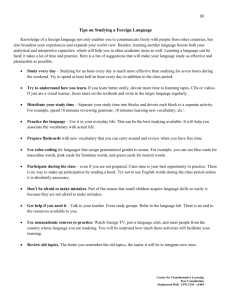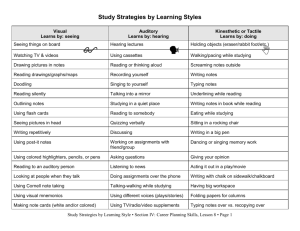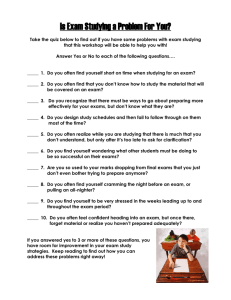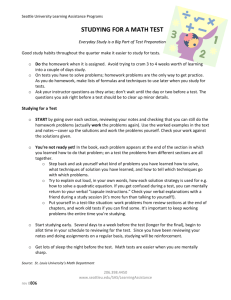Understanding How We Learn Time/Priority
advertisement
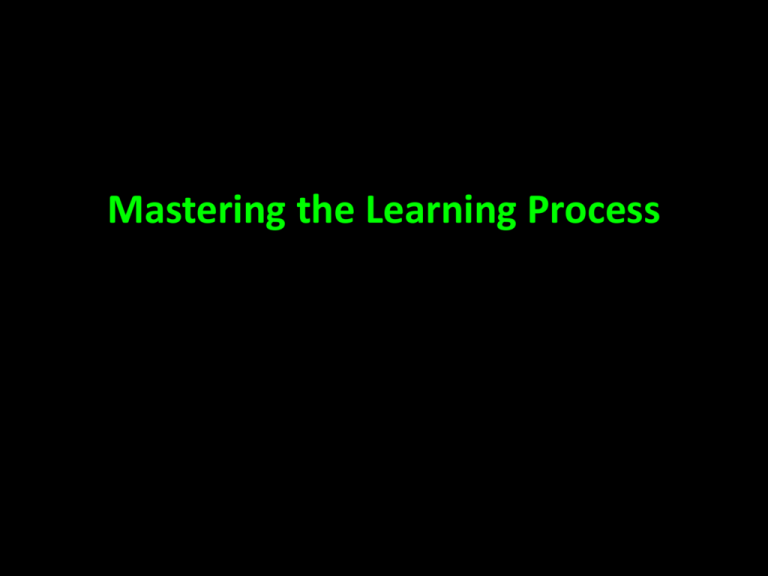
Mastering the Learning Process How Memory Works To increase the effectiveness of your studying and learning, you must understand the science behind memory. Understanding How We Learn • Contextual Clues for Memory Recall • Your brain is constantly taking in what is around you • Using triggers • Don’t create rituals for studying; Challenge your brain to recall information Understanding How We Learn • Space Studying Out • Space out studying in shorter chunks, and repeat this over time for the largest return on investment • “You’re not spending any more time. You’re not working any harder. But you remember for longer.” – Mary Roach • The farther you are from a test, have longer study intervals. The closer you are to a test, have shorter intervals. • Pomodoro Method Week 1: Initial learning – Chapters 1-2 Week 3: Review Ch. 1-4; Initial learning Ch. 5-6 Test Week 5 Review SAME material at least 2 more times in week 3 Review SAME material at least 1 more time in week 1 Review SAME material at least 1 more time in week 2 Week 2: Review Chapter 1-2 Add Initial Learning Chapter 3-4 Review SAME material at least 3 more times in week 4 Week 4: Review Ch 1-6 Understanding How We Learn • Testing As Part of Studying • Testing means practicing the concepts without any study aids • Testing yourself earlier in your study routine will also confirm for you what you don’t know, and allow you time to review this material. • When you study, then test yourself, you are more likely to remember the material later. • How can you test yourself? Understanding How We Learn • When Reviewing Material • The more multi-sensory techniques you use to learn information over time, the more neuro pathways you build. • Examples of multi-sensory techniques: • Visual • Cornell Note-Taking • Doodling • Verbal/Explanation • Teaching Others • Study Groups • Associations • Efficient Repetition • Organization • Mnemonic Tricks • Take a break! A syn-nap Understanding How We Learn • Things to Avoid • Re-writing the same thing over and over • Simple memorization and regurgitation • Cramming • Sticking with the “flash cards” model. • Moving on when you don’t understand something • Going to class without a clue as to what will be covered • Not going to class Time/Priority Management • “The key is not to prioritize what’s on your schedule, but to schedule your priorities.” – Stephen Covey • This is really more about managing all of your priorities to accomplish your goal. • You must be intentional with your time, study habits, and what you are prioritizing. • You don’t have to be a student 100% of your day! But you do need to plan so you can accomplish everything that’s important to you. Time/Priority Management • Let’s start with the BIG PICTURE – Backwards Planning (see handout) • Plan now for the super stressful weeks. What can you do not to mitigate the impact of those weeks? • The more you do now to plan your future weeks and semester, the more likely you will be able to handle things when you are very stressed. Time/Priority Management • Set Milestones and Goals • Goal Mapping (handout) • At each milestone, reflect and re-assess your habits Time/Priority Management • After you do backwards planning and set your goals, you will need to incorporate strategic decision making and planning on a daily and weekly basis • There are many ways to do this. At a minimum, you will need a basic organization tool that you use daily and week. This could be: • Planner (hard copy) • Calendar on your wall • White board • Post-it notes • Simple notebook to plan your day(s) • Electronic calendar or app • To-Do List • Personal Kanban • Priority Grid • Other methods – what do you use? Get Started Your task is to complete the following by next class: • Backwards Planning for the Semester • Set at least one milestone that occurs before the end of the semester and complete goal mapping for at least one goal. • Pick a time/organization method and use it daily/weekly (planners, Kanban, Priority grid, etc) • Pick a study technique and use it daily/weekly (spaced intervals, Cornell method, teaching, Pomodoro, etc) Online Resources: • Learning • Doodling for Learning • Ted Talk: http://www.ted.com/talks/sunni_brown • Article: http://content.time.com/time/health/article/0,8599,1882127,00.html • Cornell Method for Notetaking: http://goo.gl/WDMuni • Studying, General • Article – Teach as part of the learning process: http://goo.gl/LuviDu • Article based on the How We Learn book: http://ww2.kqed.org/mindshift/2014/08/25/how-does-the-brainlearn-best-smart-studying-strategies/ • Online tools for better attention and focus: • http://99u.com/articles/6969/10-online-tools-for-better-attention-focus • http://collegeinfogeek.com/resources/ • Time/Priority Management • Building Your Own Productivity Style: http://lifehacker.com/5828033/how-to-build-your-own-productivity-style-byremixing-from-the-best • Pomorodo Method: • http://pomodorotechnique.com/ • http://lifehacker.com/productivity-101-a-primer-to-the-pomodoro-technique-1598992730 • http://www.moosti.com/ • Personal Kanban: • http://goo.gl/vjuE9V • http://yeswekanban.net/ • Getting Things Done Philosophy • http://lifehacker.com/productivity-101-a-primer-to-the-getting-things-done-1551880955 • Mastering Your To Do List: http://lifehacker.com/5986867/david-allen-explains-how-to-master-your-to-do-list • Prioritizing • Article: How To Prioritize When Everything Is Important: http://lifehacker.com/5877111/how-to-prioritize-wheneverything-is-important • Priority Grid: http://www.usgs.gov/humancapital/documents/TimeManagementGrid.pdf • Motivation • Ted Talk: http://www.ted.com/talks/dan_pink_on_motivation?language=en


